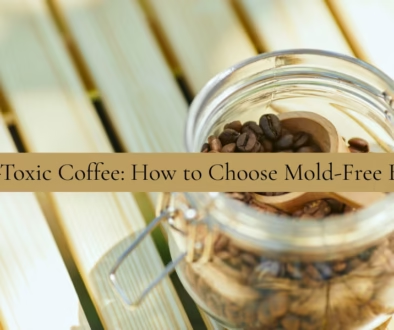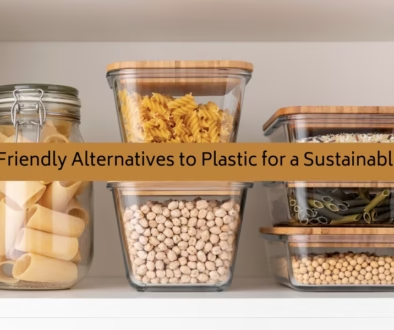
Nutrition and Non-Toxic Living: Nourishing Your Family Safely
My recent posts have focused on non-toxic living through healthy changes to the products you use in your home and your body. Today, I want to talk about the importance of nutrition in promoting your overall health. Nutrition and non-toxic living go hand-in-hand. Today’s tips will encourage you to make healthy choices, stretch your budget, and build a balanced pantry.
For some, grocery options are sensitive, and I completely understand that. I am not writing this point to cast judgment or criticism on anyone. Please know I write this post because I want to encourage you to protect your family as best you can.
Inflation is at a nauseatingly record high. Today, I want to share practical tips to help you build a non-toxic pantry while sticking to your budget.
Some topics we’ll cover in today’s post:
Understanding the benefits of organic and whole foods
Building a balanced pantry
Shopping the perimeter
Tips for meal planning and preparation
Encouraging nutrition and non-toxic living through simple recipes for the whole family
Encouraging kids to embrace non-toxic choices
How to overcome barriers to non-toxic eating
If you’re new to my blog, welcome! My name is Michaela, and I blog about motherhood, non-toxic living, and navigating our son’s journey through childhood cancer. Sharing tips on how to live a non-toxic life without breaking the bank is something I’m passionate about, and I’m so glad you’re here!
The month of September is very important in our family as it’s Childhood Cancer Awareness Month. I’ve been sharing weekly posts about childhood cancer and how to support cancer families. If you’re interested, here are my most recent posts:
How to support siblings of children with cancer
A letter to my son during his cancer fight
What I wish I had known before my son’s cancer diagnosis
And here are some recent posts on non-toxic living:
Budget-friendly cleaning swaps
We have a lot to cover today, but I promise you’ll walk away feeling more confident creating your own non-toxic pantry.
What do nutrition and non-toxic living have to do with each other?
The answer to this question is easy: absolutely everything. If you’re swapping out products you use in your home, swapping out the foods you eat is just as important! If swapping out products in your home seems overwhelming, working on your food choices is a great alternative. Nutrition and non-toxic living are intertwined; making simple swaps to your grocery list can make a huge difference.
Understanding the benefits of organic and whole foods
While organic foods are more expensive, they must meet specific guidelines to be labeled as such. We choose organic foods over conventional foods to avoid harmful pesticides, synthetic fertilizers, and hormones whenever possible.
Animal products must also be produced from animals raised in living conditions that accommodate their natural behaviors. For example, cows must be allowed to graze on a pasture, fed 100% organic feed, and never be administered antibiotics.
Foods processed with multiple ingredients have special additional regulations, including no artificial colors or flavors. They require their ingredients to be organic except for enzymes in yogurts, pectin in jams, and baking soda in baked goods. Buying organic foods ensures the highest quality ingredients for our family, but as I mentioned before, it does come at a price. For many families, buying completely organic foods is not an option. If this is the case for your family, don’t stress! Know that you are doing your best and work within your budget. Some months are really tight for us, and buying organic foods isn’t an option.
When shopping, prioritize foods that matter to you most; for us, dairy and animal products are the most important items, so when necessary, we focus on that first. If our budget allows, we move to produce and, lastly, grains.
This year, I’ve worked hard to make all our bread from home and haven’t purchased a single loaf of bread from the store. This has freed up space in our budget to allocate funds to other products that we work to ensure are only organic.
Purchasing organic, whole foods provides more nutrient-dense options for your family than processed foods while protecting you from harsh additives, preservatives, and artificial ingredients in your diet. They may keep foods fresher longer, but commonly used preservatives like MSG, sodium nitrite, gums, and artificial sweeteners are linked to health issues like ADHD, asthma, obesity, digestive disorders, and cancer.
While it’s essential to research and choose safer options, the goal here is not to live a perfectly clean life where you never expose your body to a harmful chemical again- that’s unrealistic. The goal is to be more aware, choose safer products you can afford, and trust your body to protect you. If you’re living your life in fear of every decision, that is as unhealthy as eating a fully processed diet filled with preservatives, additives, and artificial ingredients. Strike a balance and be proud of yourself for your changes.
Building a non-toxic pantry
Building a non-toxic pantry over time has been incredible for our family. We didn’t toss out every product we owned at once; we researched better alternatives, and as we ran out of a product, we would replace it with a cleaner option. Here is a master list of products to consider:
Flour
Sugars
Grains
Canned goods
Spices
Seed oils
Reading labels is incredibly important in identifying harmful additives and harsh ingredients in your products. Remember, as you run out of an ingredient, transition to a safer alternative and add the item to your budget. This will help you learn what is most important to you to budget for and which items impact your budget the most.
Shopping the perimeter of the store
When grocery shopping, focus on the perimeter of the store; this helps you avoid as many processed purchases as possible while focusing your money on fresh, whole-food products instead. Fill your cart with fresh fruits, veggies, dairy products like yogurt, cheeses, milk, meats, and whole grain options. Browsing other aisles is much safer once you’ve shopped the store’s perimeter. You are less likely to choose processed options when you’ve first shopped for these cleaner products. Now that your cart is full, adding a few treats, favorite snacks, or other items is perfectly fine. Remember, the goal is not perfection; the goal is balance. When you deprive yourself of your favorite items, even if they aren’t ‘clean,’ you are setting yourself up for failure. It’s okay to enjoy some processed products from time to time.

How to save money on organic products
Choose seasonal produce- when produce is in season, it’s much cheaper than other options, saving you money.
Consider buying in bulk- We purchase items like flour, oats, sugars, and our most consumed dairy products. This saves us money and prevents me from needing to shop for them more often, keeping me out of the store.
Research local cattle farms and purchase beef and chicken from them instead- We purchase about half a cow from a cattle ranch nearby every year, and it’s one of the best decisions we’ve ever made for our food budget. Yes, it is a large sum of money, but we budget for it every month and save up for the purchase throughout the year. We save money in the long run and have access to clean, organic meat all year.
Meal planning and preparation
In addition to baking bread every week for my family, I also sit down and plan our meals for that week before grocery shopping. I shop our pantry first, checking for ingredients needed for each meal, then I write down any items I don’t have on hand and purchase them. We don’t have a largely stocked pantry right now, simply because prices are so high that it’s not something we can do, but it ensures we aren’t wasteful and are not purchasing items we don’t truly need.

I created these seasonal weekly meal plan templates to help organize our schedule and create our grocery list, and they have helped me tremendously with staying organized, on budget, and prepared for our meals. Click to purchase and reuse over and over again!
Here’s my favorite bread recipe:
After shopping, I bake bread and other breakfast options to have on hand and prep fruits and veggies for the week. Having these items prepped at the beginning of the week helps free up time each day and helps us choose the fruits and veggies over other snacks in the pantry. Shopping every two weeks keeps me out of the grocery store more than necessary, and my children know that whatever we purchase needs to last until our next shopping trip in two weeks. We do not purchase unnecessary items or extra snacks to have on hand. Together, my children choose 1-2 snack options for those 2 weeks. When they run out, that’s it until the next trip. They can have fruits, veggies, or yogurt as often as they want, but they only get one serving of their snack choice each day.
We try to encourage healthy eating as much as possible, but our children need to learn balance as much as we do. Preaching one thing and acting out something completely different is unfair. We never use words to categorize foods as ‘bad,’ ‘dangerous,’ or ‘unhealthy.’ We simply say that some foods give us more energy and keep us full longer, while others don’t. I never want to be the cause of disordered eating habits in my children and have worked hard to avoid negative talk about food choices.
Encouraging nutrition and non-toxic living through simple recipes for the whole family
As a large family, we try to make food stretch as much as possible. We usually choose 6-8 meals and repeat them for 2 weeks before switching things up and using different recipes. Keeping meals simple is an easy way to stretch your food and get more from your budget. I do not use recipes with more than 6-7 ingredients, and I try to match those ingredients to other meals for the next 2 weeks. For example, our bi-weekly meal plan may look something like this:
M: Lasagna and French bread
T: Taco bowls
W: Sheet pan dinner
TH: Spaghetti and meatballs
F: Leftovers
SAT: Crunchwraps
SUN: Pizza night
Many of the ingredients needed for these meals overlap, helping cut back on cost and preparation without feeling like we’re eating the same thing every day. My kids love lasagna and spaghetti and ask for both meals often. They are both fairly inexpensive to make and keep them full.
Mom hack: I secretly grate up carrot, zucchini, and a little onion and add it to my meat as it’s cooking. It bulks up our meat to help stretch it further, plus my kids are getting extra veggies without much effort. I also do this when making meatballs. Grate up whatever veggies you like, add to the mix and form. I add some extra breadcrumbs to compensate for the extra moisture, which helps us stretch our meal enough for a few lunches and dinner.
I plan to share more of my favorite recipes on my blog, so stay tuned for that! In the meantime, here are some of my favorite blogs for recipes:
The Lazy Dish (I tweak as needed to fit our preferences)
Encouraging kids to embrace balanced choices
As I mentioned previously, we work hard to ensure we do not label the foods we bring into our home. As a family that has completely changed our way of living because of my son’s diagnosis, my children are aware of safer choices they can make, but they also know they are free to choose whatever they’d like, within reason. They know that I no longer purchase diet soda and that baking bread at home has saved us money and helped us to control what ingredients we expose ourselves to. They also know that I rarely say no to ice cream night because it encourages us to sit together a little longer and that Saturday mornings are for cinnamon rolls or coffee cake. We work to strike a balance and encourage our children to do the same.
By never labeling foods as good or bad and having open conversations about some of the products we used to buy and safer alternatives we can choose, we’ve kept them talking about food, about why we eat the way we do, and how to encourage them to do the same. Remember that your kids hear everything you say. If you are demonizing food, chances are they’ll do the same. Set them up for success by talking to them about why balanced food choices are so important.
Overcoming common barriers to balanced eating
Some of the most common barriers I hear when people are trying to change their eating habits are finances, time, and know-how.
Let’s cover some solutions to these common barriers.
Finances- If finances are what hold you back from transitioning to organic, whole-food options, remember to take it slow! There is no need to throw out your entire kitchen and start fresh. When you run out of one item, replace it with something safer, and keep track of the price difference. While some items are significantly higher, items, like produce and some grains do not significantly affect our budget.
Buy in bulk- One way to save on organic foods is to buy in bulk. Grains, baking necessities, and spices can be purchased in bulk to help cut back costs, allowing you to budget that money in another area.
Time- If time is holding you back from making changes, today’s tips will help you with that! Prep fruits, veggies, and easy meal options at the beginning of the week to help save time during your busy days. When making dinner, cook enough for 2 meals, freeze the second portion, or place it in the fridge.
Know-how-
Start slow. Look at one item at a time to replace and expand from there. There is no need to replace your entire kitchen in one day. Plus, you may find in time that one brand suits your preference better than another. You will learn all of this in time! Be patient with yourself and be proud of the changes you’ve made so far.

Conclusion
We covered a lot in today’s post. Nutrition and non-toxic living can be overwhelming, but it doesn’t have to be! From building a balanced pantry, encouraging children to embrace balanced choices, meal planning tips, money-saving hacks, and more. I hope you feel encouraged to look at your nutritional choices and balance them out. Remember, you do not need to change everything in your home simultaneously. Making changes to encourage better nutrition and non-toxic living should happen over time. Make sure these changes are sustainable!
Thank you so much for being here. If this post has been helpful to you, please remember to share it with a friend and pin it to your favorite board on Pinterest!
Until next time,
-M

This site may contain links to affiliate websites including Amazon. I may receive an affiliate commission for any purchases made by you through Amazon or other potential affiliates and no additional cost to you. Thank you for your support.




